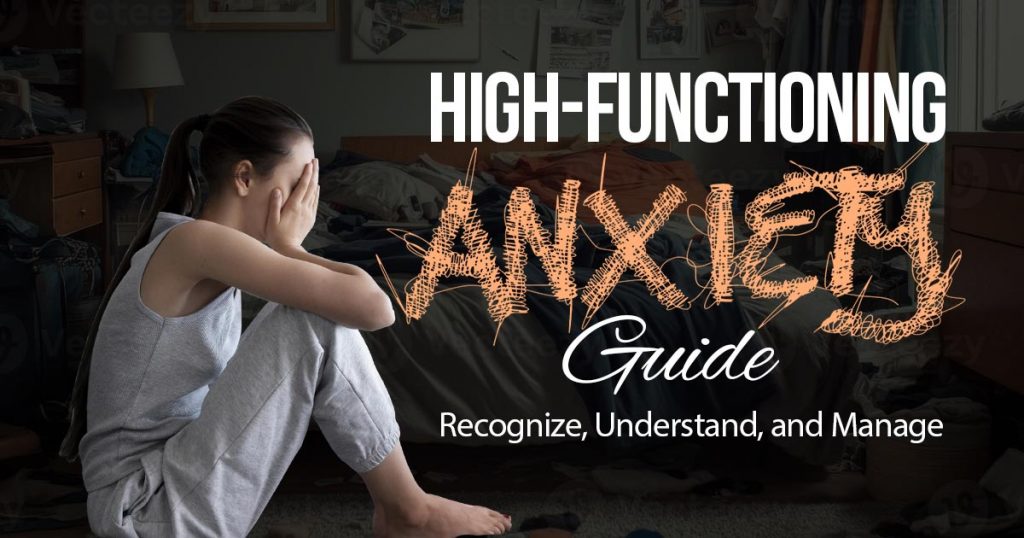Anxiety is one of those things most of us experience at some point. It’s that nervous energy before a big meeting or the nagging worry about a project you’ve got due. But for some people, anxiety doesn’t just show up occasionally. It’s a constant companion, wrapped up in the drive to “handle everything perfectly.” This is often what people mean when they talk about high-functioning anxiety.
Did you know that out of the 40 million adults in the U.S. living with anxiety disorders, around 18% fall into this category? That’s a huge number! If you’ve been told things like, “You always seem so on top of it all,” but inside you feel like you’re barely keeping it together, you’re not alone. High-functioning anxiety can make life feel like you’re walking a tightrope. Here’s a guide to help you understand and manage it.
What’s High-Functioning Anxiety?
High-functioning anxiety isn’t a label your doctor will diagnose you with, but it’s a term many people use to describe the experience of dealing with anxiety while still looking like you’ve “got it all together.” You might hit all your deadlines, keep up with relationships, and smile through the day, but inside, you’re overthinking every interaction and juggling constant worries.
Think of it like this: You’re a duck gliding effortlessly on the water, but under the surface, your legs are paddling like crazy. To anyone watching, everything seems fine, but only you know how exhausting it feels to stay afloat.
Signs High-Functioning Anxiety Might Be Your Reality
Here’s a checklist to see if anything resonates with you:
- Perfectionism Rules Everything: You can’t just do a good job; it has to be perfect, or it’s not good enough.
- Never Stop Thinking: Decisions that seem small, like choosing a lunch spot, turn into hours of debate in your head.
- Rest Is Hard: Even when you’ve got nothing to do, you find yourself scrolling emails, thinking about tomorrow, or organizing something “just because.”
- Physical Stress: Maybe your jaw always feels tight, your back constantly aches, or you’ve had your fair share of sleepless nights. Anxiety can show up in your body as much as in your mind.
The thing about high-functioning anxiety is that on the outside, everything looks great, but the energy it takes to keep it together can be overwhelming.
How to Manage High-Functioning Anxiety
Managing high-functioning anxiety doesn’t mean you need to change who you are. It’s about finding ways to quiet that inner storm. Here’s what you can try:
1. Spot Your Triggers
Pay attention to the situations that crank up your anxiety. Maybe it’s tight work deadlines or overly critical comments from a family member. Once you recognize what sets you off, you can plan better or set boundaries in those situations.
For example, if meetings tend to stress you out, give yourself 10 minutes beforehand to take some deep breaths and jot down a couple of go-to responses to lean on if your mind goes blank.
2. Don’t Underestimate the Power of Therapy
Talking to someone who knows how to guide you through anxiety can work wonders. Cognitive-behavioral therapy (CBT) is particularly handy because it teaches you how to catch and reframe those anxious thoughts before they spiral.
For instance, instead of thinking, “If I mess this up, I’ll ruin everything,” CBT can help you reshape it to something like, “One mistake doesn’t erase everything I’ve accomplished.”
3. Take It Slow with Lifestyle Shifts
If therapy feels like a big commitment right now, that’s okay. Start with smaller changes to how you live your daily life:
- Stick to Simple Routines: Sleep and eat on a regular schedule. Anxiety thrives on chaos, so keeping a rhythm helps calm your mind.
- Move Your Body: Even a 10-minute walk can release feel-good hormones like endorphins, which naturally combat stress.
- Set Little Boundaries: It doesn’t have to be dramatic. Practice saying “no” to things you can’t realistically fit into your day, whether it’s an extra task at work or dinner plans you’re too tired for.
4. The Moment Anxiety Hits
When you’re mid-panic, grounding techniques can help pull your mind back to the present. One great option is the 5-4-3-2-1 technique, where you list:
- 5 things you can see,
- 4 things you can touch,
- 3 things you can hear,
- 2 things you can smell, and
- 1 thing you can taste.
It’s simple, but it works as a quick distraction from racing thoughts.
5. Write Down Your Worries
If your thoughts are racing, try writing them down in a notebook. Whether they’re worries, to-dos, or anything weighing on your mind, putting them on paper can provide relief and clarity. It’s a simple way to clear your head, especially before bed.
6. Ease Sleep and Restlessness Together
Combine simple habits to address sleep and restlessness. Create a calming bedtime routine with activities like light stretches, meditation, or reading to help you relax. Avoid caffeine in the afternoon and keep your bedroom a tech-free zone meant only for rest. For moments of restlessness, try deep breathing exercises like the 4-6 pattern (inhale for 4 counts, exhale for 6).
Supporting Someone with High-Functioning Anxiety
If you or someone close to you is dealing with high-functioning anxiety, take a moment to acknowledge it. Sometimes just being there for someone and saying, “That sounds tough,” can make a huge difference. Encourage open conversations, but don’t rush them into anything they’re not ready for, like seeking professional help. They’ll move forward when they’re ready.
And if it’s you going through this, give yourself some credit. Seriously, recognizing you’re struggling is already a big step. You don’t have to figure it all out today. Take it one small step at a time, and don’t forget, it’s okay to just breathe and be. You’re doing better than you think, and you’re not alone in this.
